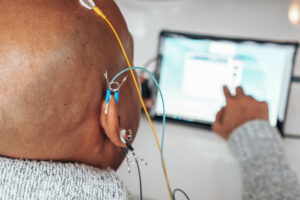What is Neurofeedback Therapy?
Neurofeedback therapy is an approach to improving brain function in some way, be that for helping a person’s mental health or for improving performance across many areas. In fact, mental health is brain performance too. Neurofeedback therapy is any approach that reads the activity of the brain and then passes information back to the brain via EEG to improve the way it functions. The feedback is usually delivered through an audio or visual stream.
Sometimes I hear people tell me that there is nothing wrong with their brain because they feel that targetting brain performance means there is something wrong with them. However, when you consider that the brain is involved in every process in the body and mind, then it’s easier to think that improving brain performance could be a good thing and not an indication that your brain is flawed. I have yet to meet someone who didn’t understand that upgrading or optimising a computer is a good idea if it isn’t performing as you’d like. In many ways that’s what neurofeedback therapy is doing.

A little about the Brain
While understanding the brain is a big topic, it is helpful to understand that the brain is constantly monitoring information from inside and outside of the body. We tend to live our lives immersed in our subjective experience, our thoughts, feelings and perspectives on what is happening. It is important to understand though that the brain is looking for tiny differences in sensory information such as changes in light intensity, temperature, movement in our field of view etc in order to calculate what it needs to do to keep us safe and well. It is also reacting to internal information delivered by our many bodily system such as the nervous system about electrochemical changes, muscular activity, changes in movement in space and of course making calculation and predictions about how our internal state interacts with sensory data about the outside world.
The brain is always seeking to help us be efficient and effective in survival. It is pre programmed to self regulate and it also learns from our experience, creating habits and maps for how to navigate our internal and external environment. Sometimes that learning needs to be updated and this is where neurofeedback therapy helps.
The two approaches to Neurofeedback Therapy
There are fundamentally two approaches to neurofeedback therapy, which I explain in more detail here. As a quick summary, please read on:
Linear Neurofeedback
The first approach involves training the brain to change its activity towards a desired state and away from a specific undesired state, for example to help with anxiety or ADHD. Linear Neurofeedback trains the brain through reward. When it achieves the desired brain wave pattern it is rewarded by the video or audio stream become clearer. This approach requires a highly skilled clinician to guide the process and to tweak the training based on how the client reacts during a session and in between sessions. The clinician is guided by normative data about how ‘statistically average’ brains operate.
The term Neurofeedback therapy is most relevant with this type of neurofeedbakc because it’s specific aim to target diagnoses and conditions.
Dynamical Neurofeedback
The second approach is philosophically different because it is based on the knowledge that there are no fixed brain patterns for emotions and performance. Every brain is unique and ever changing/ adapting, millisecond by millisecond. The brain and body is a dynamical system just as the weather is, it never stands still or remains static. The brain and body are already self regulating i.e. they already know how to adapt in order to survive, it’s just that the body and brain learn how to do things and then create habits around this learning and sometimes this learning needs updating. With Dynamical Neurofeedback you give the brain information about what it is already doing then it will autocorrect any inefficiencies. The information is delivered via little breaks in a music stream. Without this information to prompt reassessment of its activity, it often continues its habitual patterns.
With this approach Neurofeedback training is a more appropriate term than therapy because, while the outcome is experienced as therapeutic in many cases, the training is aimed at whole brain optimisation rather than symptom reduction.
Neurofeedback Therapy and Neuroplasticity
Since technology allowed us to see what is going on inside the brain, we have been able to understand that the brain constantly evolves and changes. We can continue to learn and grow as people. Yes, this ability does diminish over our life span and at the new born stage the brain is at its most flexible, but we have come a long way from the days where we were seen as fixed entities, unable to change.
Neurofeedback therapy harnesses the brain’s natural ability to change and grow in very helpful ways that aren’t achieved through conventional means. This approach is extremely helpful for emotional struggles as well as helping achieve and maintain peak performance.
Integrating Neurofeedback into my therapy practice
As a psychotherapist I am aware that many people do not benefit from talking therapy. In the UK, neurofeedback therapy is not well known and there seems to be an expectation that talking therapy is key for all emotional struggles. There is no doubt that therapy is extremely helpful in many cases but there are too many people out there looking for an alternative to therapy that can support their emotional wellness.
When I discovered NeurOptimal neurofeedback through my own journey to find the cure for insomnia I was suffering with, I knew that I had found a wonderful tool that would help many people with emotional dysregulation issues to a level previously unattainable. Since offering in office sessions and NeurOptimal home rental systems in 2020, I have seen the demand steadily grow as people catch onto this wonderful technology.
While it isn’t the panacea for all ills and mental health and peak performance remain a complex subject, it is an alternative and complimentary tool for health and wellness that I recommend to everyone. It has without doubt been the most helpful approach in my life for delivering energy, focus, emotional stability and resilience.
